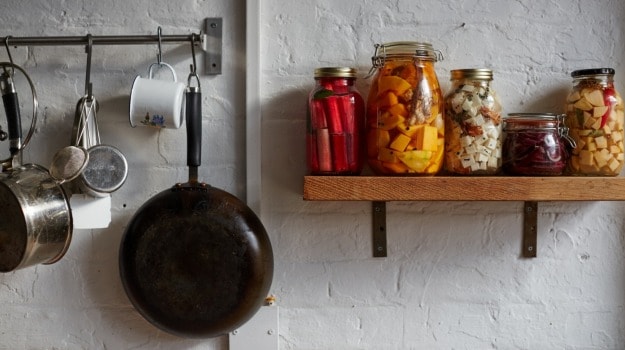In a pickle ... rhubarb, pumpkin, kohlrabi, red onion and swede. Photograph: Elena Heatherwick for the Guardian.
Travel taught eco-chef Tom Hunt not only to eat mindfully, but also how to get the best flavours and nutrients out of seasonal produce. Here, he shows fermentation not only preserves food, but reveals hidden flavours.
As I snoozed on the porch, I was startled by a loud, melodic mantra: "Empanada de pinaaaa!" It took a few seconds to translate the words in my doze-addled head ... "Pineapple pasty!"
I leapt from my rocking chair and ran over to the pedlar. She was wearing a brilliant white dress - remarkable in this dusty place - and hauling an open wicker basket containing golden empanadas, each one the size of a slipper. They were perfectly flaky, oozing sticky pineapple jam and covered with crystals of sugar, which glistened in the midday sunlight. I bought two, ate them both and was immediately filled with guilt. Here in Aserradores, a fishing village in Nicaragua, I'd just spent a month eating nothing but whole fruits, a diet brought to a sudden end. Those few joyous mouthfuls saw my bloodstream surge with refined sugar and wheat, virtual strangers to my body after all those weeks of little more than bananas and avocados.
I'd been travelling in Central America for several months and, though I loved everything about its feral beauty and vibrant cultures, was troubled by the poverty. Eating luxuries - rich foods served in restaurants or expensive packaged products - felt inappropriate, and I realised that doing so wouldn't enhance my travels. This was an opportunity to let my system recharge, to go back to nature.
Ultimately, eating this way during my travels gave my culinary brain and chef's belly a rest and helped me to regain my interest in food (an interest that was made manifest that day in Nicaragua, in the form of delectable pastries). Those two empanadas were definitely worth it and, though I initially felt guilty about the glorious sugar hit, I resolved always to be selective about how I indulged in future.
Eating consciously is now more important to me than ever. I do eat foods that are both unhealthy and unethical from time to time, but no longer feel bad when I do - we all need our treats. But eating mindfully most of the time has led me to be in tune with my body's needs and to consume more high-welfare (seasonal and organic) foods. Cooking and eating are activities to be enjoyed, but they are also deeply political acts: what we eat has a global impact, and for this reason our individual decisions about what we buy, and where we buy it from, are crucial.
Travelling and health-consciousness have continued to play an important role in my cooking. While I have an unbending passion for British seasonal produce and rarely use anything else. I also take constant inspiration from what I've learned abroad.

Pickling produce, fermenting flavour ... Tom thinks of a time before fridges.Photograph: Elena Heatherwick for the Guardian
In India I learned how to cook with true thrift: not to peel vegetables unless absolutely necessary and even then to do so sparingly. I remember approaching a street vendor in Varanasi and asking him to teach me how to cook his dishes. He eagerly invited me to his home and showed me how to make masala dosa, an Indian pancake made from fermented dhal and rice, filled with masala potatoes. He took great care with his vegetables. His technique for preparing ginger was particularly memorable: he rubbed the skin off with the back of a knife, and wasted nothing of the edible root. It's a trick I've adopted in my own cooking, like the ferments here. The kohlrabi is not peeled, the celeriac skin can be reserved to make crisps and the pumpkin seeds saved either to plant or to be dried in the oven for a chewy snack.
I've paired British seasonal produce here with spices from around the world: pumpkin with cassia bark and ginger, and rhubarb with mustard seeds and cloves ... The spiced brine solution creates a surprising aromatic fizz in the fruit and vegetables, making them an ideal accompaniment for cheese and meats, or delicious sides to have on their own.
Fermenting is both one of the simplest ways to prepare food and an effective form of preservation. Before we had fridges, the life of many fresh products was prolonged using this kind of technique, but with experimentation I have realised that fermentation has more than just a practical purpose: it's a way of understanding flavour. Over time, each fermented ingredient develops an intensity magnified by the salt. Try any of the recipes below, and you'll find that a ferment is like a paint palette - a place both to mix different combinations of flavours, and to discover new ones.
Fermentation: One recipe, six seasonal vegetables to pickle and ferment
You can ferment or pickle just about anything from apples to snails. Pickling is a rewarding way to make the most of seasonal ingredients, or indeed a surplus of produce you may already have in your fridge. I cook with colours as well as flavours; we feast with our eyes before our mouths, so the aesthetics of a dish are all-important. These won't disappoint.
To fill a 1 litre jar
800g of a prepared seasonal vegetable
460ml water
1 tbsp sea salt
1 tsp each of 1, 2 or 3 different aromatics and spices, such as ginger, cassia, garlic cloves, peppercorns, nigella seeds, mace, thyme, dill seeds, mustard seeds
1 Sterilise your jar by washing it in very hot water then placing it on its side in a cold oven. Turn the oven on to 150C and when it reaches temperature turn it off. Leave the jar until needed.
2 Sterilise the lid by bringing it to the boil in a saucepan of water. Leave in the water until needed.
3 Clean and, if necessary, peel your chosen vegetable and cut into 1-2cm thick sticks, slices or cubes. Pack tightly into a sterilised jar, topped with a combination of your chosen aromatics and spices.
4 Dissolve the salt in the water to make a brine. Pour it over the vegetables and make sure they are submerged. Leave at room temperature for four days or until they start to bubble. Then refrigerate for up to one month.
Six fermentation ideas
Pumpkin, fresh ginger, cassia bark, garlic, peppercorns.
Celeriac, nigella seeds, whole mace blades, thyme, garlic.
Red onion, dill seeds.
Rhubarb, mustard seeds, clove, bay leaf.
Swede, fresh ginger, curry leaves, chilli.
Kohlrabi (skin left on, peeled into shavings with a peeler), lime leaf, lemongrass, coriander seeds.








